“There was, among certain filmgoers in the 1960s, an appetite for difficulty, a conviction that symbolic obscurity and psychological alienation were authentic responses to the state of the world. More than that, the idea that a difficult work had special value — that being challenged was a distinct form of pleasure — enjoyed a prestige, at the time, that is almost unimaginable today. We would rather be teased than troubled, and the measure of artistic sophistication is cleverness rather than seriousness.
“Given all that, it may be hard for someone who wasn√ɬ¢√¢‚Äö¬¨√¢‚Äû¬¢t there — who never knew a film culture in which La Notte didn√ɬ¢√¢‚Äö¬¨√¢‚Äû¬¢t already exist — to quite appreciate the heroic status conferred on Michelangelo Antonioni and Ingmar Bergman 40 years ago. I don√ɬ¢√¢‚Äö¬¨√¢‚Äû¬¢t believe that the art of filmmaking has necessarily declined since then (I√ɬ¢√¢‚Äö¬¨√¢‚Äû¬¢d quit my job if I did), but it seems clear the cultural climate that made it possible to hail filmmakers as supreme artists has vanished for good. All that√ɬ¢√¢‚Äö¬¨√¢‚Äû¬¢s left are the films.” — N.Y. Times critic A.O. Scott on the passing of Antonioni and Bergman two days ago.
Day: August 1, 2007
“Shoot ‘Em Up” site
A decent Shoot “em Up website is finally up. Decent but hardly innovative or wonderful. A really good site would let the viewer see the original moving stick-figure drawings that director Michael Davis drew to sell the movie (i.e., how he intended to shoot it) to would-be financiers.
Nicholson and “Showgirls”
I sat through a memorable showing of Showgirls once at Robert Evans‘ Beverly Hills home in the early fall of ’95. In Evans’ legendary rear bungalow, that is, behind his egg-shaped pool in the backyard of his French chateau-styled place on Woodland Avenue. With Jack Nicholson of all people, as well as Bryan Singer, Chris McQuarrie, Tom DeSanto and two or three others. With everyone hating it but sitting through the damn thing anyway because Nicholson had come over to see it and nobody wanted to be contrary.
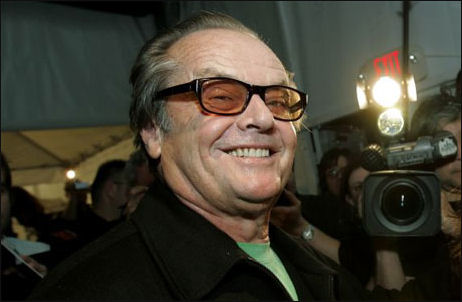
All that ended when Nicholson, who was sitting right under the projection window against the rear wall, stretched his arms and put his two hands right in front of the lamp. The resulting hand-silhouette on top of Elizabeth Berkeley and her grinding costars conveyed his opinion well enough, and suddenly everyone felt at liberty to talk and groan and make cracks and leave for cigarette breaks. Nicholson and Singer ducked out at one point, and I joined them. (I had recently seen Paul Verhoeven‘s film and had no desire to suffer a second time.)
I was Evans’ journalist pal that year. I had written a big piece about Hollywood Republicans earlier that year for Los Angeles magazine, and Evans had been a very helpful source. As a favor I’d arranged for him to meet some just-emerging GenX filmmakers — Owen Wilson, Don Murphy, Jane Hamsher, et. al. — so that maybe, just maybe, he could possibly talk about making films with them down the road.
Anyway, it was sometime in late September and Evans, myself, Singer, DeSanto and McQuarrie were having dinner in the back house, and Evans was doing a superb job of not asking the younger guys anything about themselves. He spoke only about his past, his lore, his legend. But the food was excellent and the vibe was cool and settled.
Then out of the blue (or out of the black of night) a window opened and Nicholson, wearing his trademark shades, popped his head in and announced to everyone without saying hello that “you guys should finish…don’t worry, don’t hurry or anything…we’ll just be in the house…take your time.”
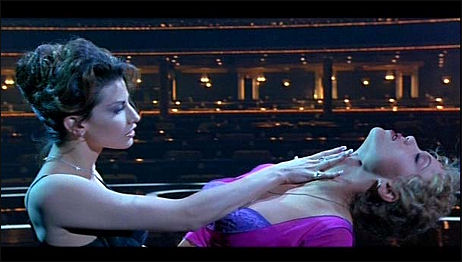
What? Singer, McQuarrie and DeSanto glanced at each other. Did that just happen? Evans told us that Nicholson was there to watch Showgirls, which they’d made arrangements for much earlier. He invited us stay and watch if we wanted. Nobody wanted to sit through Showgirls — the word was out on it — but missing out on the Nicholson schmooze time was, of course, out of the question.
There was a little talk after it ended. I recall DeSanto (Apt Pupil, X-Men, X2, Transformers) introducing himself to Nicholson and Jack, who had brought two women with him, saying, “And it’s very nice to meet you, Tom.” Gesturing towards Girl #1, he then said to DeSanto, “And I’d like you to meet Cindy and…” Lethal pause. Nicholson had forgotten the other woman’s name. He recovered by grinning and saying with a certain flourish, “Well, these are the girls!” The woman he’d blanked on gave Nicholson an awful look.
We all said goodbye in the foyer of Evans’ main home. Nicholson’s mood was giddy, silly; he was laughing like a teenaged kid who’d just chugged two 16-ounce cans of beer and didn’t care about anything. I was thinking it must be fun to be able to pretty much follow whatever urge or mood comes to mind, knowing that you probably won’t be turned down or told “no” as long as you use a little charm.
Worst Big Film Ever
The Sydney Morning Herald‘s 8.1. byline-free piece about the five biggest stinkers of all time — Elaine May‘s Ishtar, Michael Cimino‘s Heaven’s Gate, Paul Verhoeven‘s Showgirls, Oliver Stone‘s Alexander; and Kevin Reynolds‘ Waterworld — finally decides that Showgirls is the worst of all.
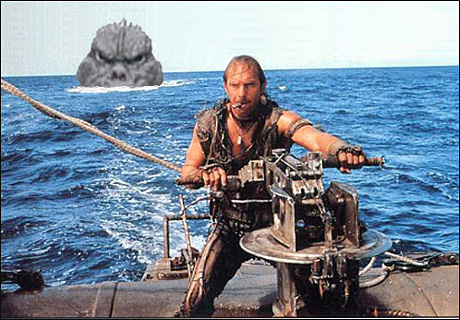
I say it’s Waterworld because of two things. One, the decision to shoot in 1.85 instead of 2.35 Scope — part of the idea, obviously, was to convey the vastness of a world covered in water, and the widescreen aspect ratio would have certainly given audiences a better feel for this. And two, the fact that Waterworld‘s huge budget and all that location shooting off the big island of Hawaii led to almost nothing memorable. Alfred Hitchcock did a better job of capturing the magnificent energy, terror and turbulence of the ocean in Lifeboat, which was shot in a studio tank with rear-screen projection.
Of course, these five are only the bad or calamity-ridden films that got the most press. There have been many films more painful to watch than these.
My Damn Channel
What’s so wonderful about My Damn Channel? It’s okay, it’s fine…but I’m not getting the accelerated pulse-rate thing. This background piece by Time‘s Rebecca Winters Keegan doesn’t quite explain the mystique of it either.
O’Casey on Blowup mystery
According to Blowup costar Ronan O’Casey, who explained the full, partially-unfilmed plot of Michelangelo Antonioni‘s 1996 classic to Roger Ebert seven years ago, the inattention paid to the murder plot — on Antonioni’s part as well as that of David Hemming‘s photographer character — was a kind of accident. Antonioni was forced to go all mysterious and inconclusive, he says, because producer Carlo Ponti shut the film down before all the scenes were shot.
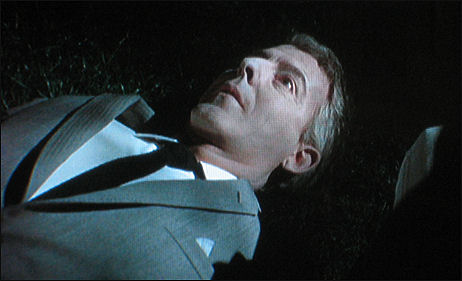
Ronan O’Casey’s only Blowup closeup
“The intended story was as follows: the young lover, armed with a pistol, was to precede Vanessa [Redgrave] and me to Maryon Park in London, conceal himself in the bushes and await our arrival,” O’Casey explains. “I pick up Vanessa in a nice new dark green Jaguar and we drive through London — giving Antonioni a chance to film that swinging, trendy, sixties city of the Beatles, Mary Quant, the Rolling Stones, and Carnaby Street. We stop and I buy Vanessa a man’s watch, which she wears throughout the rest of the film.
“We then saunter into the park, stopping now and then to kiss (lucky me). In the center of the park, Vanessa gives me a passionate embrace and prolonged kiss, and glances at the spot where her new lover is hiding. He shoots me (unlucky me), and the two leave the park intending to drive away. Their plans goes awry when he notices Hemmings with his camera and fears that Hemmings has photos of her. As it turns out, he has.

“None of this was ever shot. There were other scenes, such as those between Sarah Miles and Jeremy Glover [i.e, Vanessa’s character’s boyfriend who was also the trigger man in Maryon Park] that also went unrealized. Some of the scenes that were shot pertaining to the murder plot ended up in the film, but are completely puzzling to the audience. For example, in the film there is a scene with Vanessa and Hemmings at a cafe.” Wrong! The scene hes’ describing is between Hemmings and his bearded book editor.] A young man approaches, notices that she is with Hemmings, and runs away. That’s Glover. This makes for an odd, mysterious moment because the audience is completely ignorant of his identity.”
Ponti did Antonioni a favor, of course. If the all of this murder-plot, watch-buying stuff had been filmed and integrated into the film, Blowup would have been a much lesser work. That moment when Glover approaches the cafe and then walks away is perfect — absolutely perfect.
Animals on the streets
Three days ago L.A. Times guy Geoff Boucher wrote about getting sucker-punched by some tattooed, shaved-head, cutoff-wearing hormone monster in San Diego’s Gaslamp district during Comic-Con, and getting knocked to the ground and going home the next day with staples in his head.
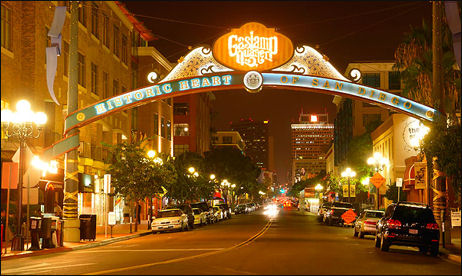
And then yesterday Transformers and Shoot ‘Em Up producer Don Murphy posted a comment on Anne Thompson‘s blog saying that he and his wife “suffered a similar attack [last] Thursday night/Friday morning that left us in the emergency room for hours….we were with a group of twelve, six people attacked, two arrested.”
Boucher writes that “the cops at the scene said this sort of incident isn’t that rare” — i.e., is somewhat common — and commenters on the Boucher essay page, some of them San Diego residents, haven’t strenuously disagreed with a with a commenter named “Rob D” calling the Gaslamp district “a magnet for stupidity…on any given night during the summer you’ll see people stumbling into the street, hanging on street lights and yelling incoherent drunken shit..[the area is] literally a haven for the retarded.”
This is an issue that Comic-Con and the city of San Diego need to address. The remedy, obviously, is hiring extra security to patrol the Gaslamp streets, and to keep a particular eye on beefy 20-something apes with shaved heads and tattoos and other sartorial indications of rage and alienation. This is not an issue for geeks — the Comic-Con faithful are generally cool, cerebral, spiritually impassioned types who would never pop anyone — but the simian under-class types that hang out in the neighborhod adjacent to the San Diego Convention Center.
It’s not unheard of for lower-class brutes of any municipality to express loathing for the connected cell-phone class that visits for a film festival or whatever.
Six or seven years ago I was talking to someone on my Motorola while standing on Park City’s Main Street during the Sundance Film Festival, and some townie drove by in a Chevy Silverado and yelled out, “Look — another asshole with a cellphone!” I yelled back, “Look — another asshole in a pickup truck!” The truck immediately pulled over and two guys got out and charged over, obviously looking to get down, but I went into my Matrix Reloaded mode and in less than ten seconds they were both moaning on the pavement, in the fetal position and begging for mercy. I wailed on them again for good measure, and they cried and whimpered like the pathetic bitches they were and always will be.
Okay, everything after the word “truck” is made up. As if I needed to say that.
“Shoot ‘Em Up” dispute
On one hand, the somewhat-New-Line-partial David Poland has called Michael Davis‘s Shoot ‘Em Up “grindhouse dim sum…unbelievably tasty and surprising and engaging stuff…a joyous plate of entertainment…a watchable enjoyable experience…good junk!” On the other, Variety‘s Peter Debruge is calling it “violent and vile in equal measure” as well as “shamelessly sordid” and “gonzo” in the vein of Running Scared, The Boondock Saints, Domino and Smokin’ Aces, and yet — important passage, this — “too stylistically audacious to dismiss outright.” I’d love to get into this myself, but the defining terms have obviously already been drawn. You either have a taste for low-brow vitality, or you don’t.
“Once” at the Landmark
Fox Searchlight and Landmark Cinemas hosted an industry/journo shindig (screening, party, performance) last night for Once, which is right now receiving a fresh TV-ad push and personal-appearance promotion by costars Glen Hansard and Marketa Irglova. Here’s a slow-loading but better quality wav file of their performance of “Falling Slowly”, and here’s an mp3 file of “When Your Mind’s Made Up”.
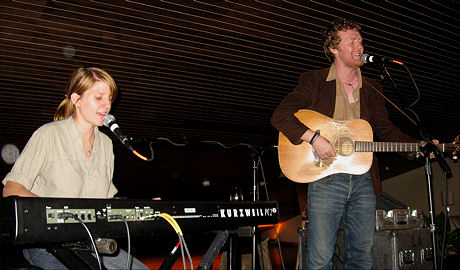
Once costars Marketa Irglova, Glen Hansard performing in the lounge/bar within West L.A.’s Landmark plex — Tuesday, 7.31.07, 9:25 pm

Fox Searchlight marketing president Nancy Utley, Marketa Irglova, Glen Hansard, Fox Searchlight prez Peter Rice at last night’s soiree.
Glen and Marketa are playing this evening at a sold-out show at the El Rey on Wilshire. They visited Jay Leno on Monday night; a visit with Carson Daly airs on Friday, 8.3. Hansard and The Frames are going to be touring with Bob Dylan in New Zealand and Australia throughout most of August. All that’s left to happen now is for the film to show up in more theatres so the live-wires who are still saying “Never heard of it!” will perhaps give this perfect little film a looksee.
